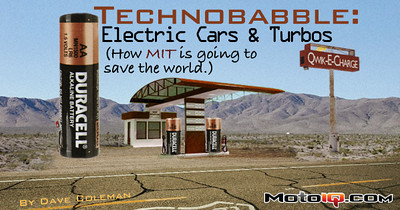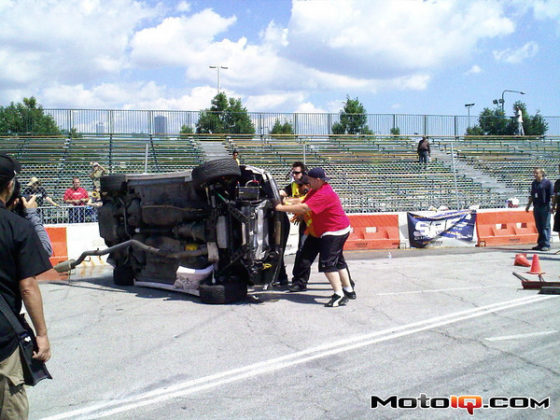
Technobabble:
Electric Cars & Turbos (How MIT is Going to Save the Wolrd)
by Dave Coleman
A few months ago, a short press release fluttered across the internet. It was about MIT researchers and some breakthrough in battery technology. All the normal media outlets regurgitated the release, proclaimed the results as exciting, and all was forgotten.
It would be easy to miss this story amid all the noise about hybrid this and electric that, but something stands out about this particular breakthrough. This looks very much like The One. This could very well be the breakthrough that's single-handedly makes electric cars stop sucking.
The breakthrough is this: Through what must have been an excruciatingly boring analysis of electron flow in a charging lithium iron battery, two heroic nerds (Byoungwoo Kang & Gerbrand Ceder) figured out exactly what was making it take so long to charge. Then they fixed the bottleneck by, effectively, greasing the microscopic tracks the electrons slide around on, making them boogie into the battery a staggering 36 times faster!
Suddenly, their little flashlight-sized prototype battery that normally took 6 minutes to charge, could be charged in only 10 seconds. Brief pause for the obligatory exclamation of religiously sacred excrement.
Finished? Ok, now apply that same factor-of-36 improvement to a car-sized battery. If a conventional electric car takes 8 hours to charge, one equipped with a magic MIT battery could do it in only 13 minutes.
Think for a second about what that does to electric cars. In our world, gas-powered cars are the pure, mechanical expression of freedom. They are instant, cheap mobility on a fantastic scale, that let normal humans, who can only cover a few miles if left to their natural-born feet, go hundreds of miles on a whim. No planning, no tickets, just a wild hair to drive to San Francisco is all you need, and any old Craigslist clunker can get you there.
Electric cars, on the other hand, are commuting appliances. With limited range and excruciating re-charge times, they are good for little more than your soul-crushing drive to and from work. Sure, commuting to work may be all you ever do, but that's not the point. You want to imagine that you'll actually decide to go somewhere fun, and gasoline enables this fantasy life.
But in this magical MIT world, electric cars can do that too. Drive 100 miles, stop, plug in, take a leak, and keep going.
Best of all, this new technology isn't really that new. It's a refinement of how lithium ion batteries are already made, meaning it can go from MIT fantasy world to your real world in record time. They're claiming less than 5 years to bring these babies to market, and they've already licensed the technology to multiple battery manufacturers.
Those of you able to see the big picture have already spotted the next obvious problem. Dumping 50 kilowatt-hours of juice (roughly the size of a Tesla battery) into your car in 10 minutes will blow up every transformer in a 10-mile radius. The electrical grid just isn't equipped to handle spikes that big, nor is it really capable, in most areas, of supplying all the extra energy that would be needed to power all of our cars. Time, then, to step from MIT's magical world into mine.
In my magical world, you could have electricity stations, conveniently located near busy streets and intersections, that could slowly charge up big batteries, supercapacitors, carbon fiber flywheels, or whatever energy storage mechanism seems cheapest at the time. They would charge up at night, when the grid has surplus capacity, and rates are typically lower, then they could sell it to MIT nerds to jolt their electric cars back to life during the day, turning a tidy profit to cover their storage and high-amperage delivery service. At home, you can slowly charge overnight, so you'd only have to use the high-amperage electron stations if you out-drive your charge during the day. In other words, only on the rare day where your fantasy life meets your pathetic real life.
This quick-charge capability does more than extend range and enable freedoms hitherto known only to hydrocarbon poppers, it also fundamentally changes the car. Electric cars should be simpler and lighter than gas cars, considering how small and efficient electric motors are, but the batteries ruin everything. With charges taking hours, any electric car needs to have a 150-mile range to be taken seriously, and that takes hundreds of extra pounds of batteries.
Supporting that weight requires a stronger chassis, beefier suspension, bigger brakes, heavier wheels and tires… weight is contagious. But if you can re-charge the car in less time than it takes to water the lillies, a car with a 40 or 50-mile range isn't really a problem. (Remember, this is a car that always leaves your house, and probably your work, with a full charge.) A lithium-ion powered electric car with that kind of range could be Lotus light, and a hell of a lot more fun to drive.
But where to put these fanciful quick-charge stations? I dunno, maybe in the same gas stations these MIT boys are trying to put out of business?



